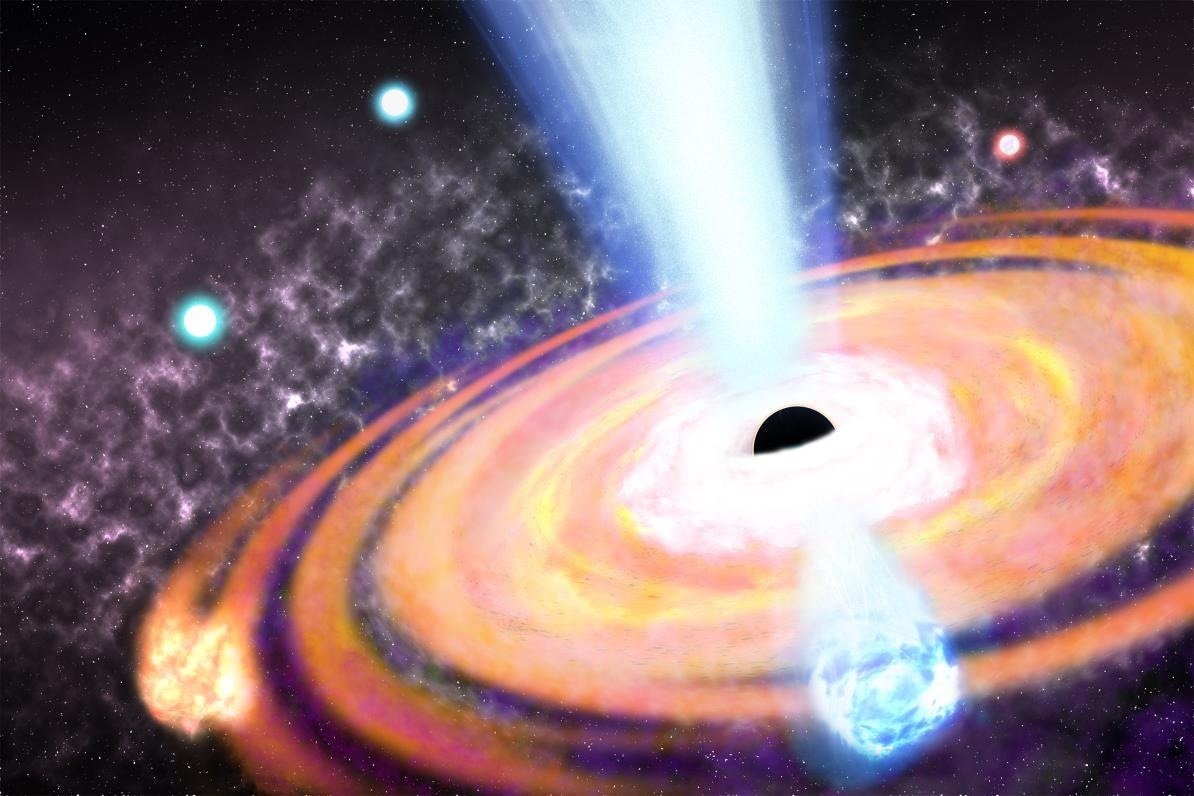A recent analysis of data from the James Webb Space Telescope suggests that black holes not only existed at the beginning of time but also gave birth to new stars and accelerated the formation of galaxies.

An illustration of a magnetic field generated by a supermassive black hole in the early universe, showing turbulent plasma outflows that turn gas clouds into stars. Image Credit: Illustration by Roberto Molar Candanosa/JHU
The discoveries challenge the conventional wisdom that black holes formed after the first stars and galaxies appeared, upending theories about how they shape the universe. Rather, during the first 50 million years of the universe - a brief era in its 13.8 billion-year history - black holes may have dramatically accelerated the birth of new stars.
We know these monster black holes exist at the center of galaxies near our Milky Way, but the big surprise now is that they were present at the beginning of the universe as well and were almost like building blocks or seeds for early galaxies. They really boosted everything, like gigantic amplifiers of star formation, which is a whole turnaround of what we thought possible before - so much so that this could completely shake up our understanding of how galaxies form.
Joseph Silk, Lead Author and Professor, Department of Physics and Astronomy, Johns Hopkins University
The work is published in the Astrophysical Journal Letters.
According to Silk, distant galaxies from the early universe that have been observed with the Webb telescope appear much brighter than scientists had anticipated and showed an exceptionally high concentration of supermassive black holes and young stars.
According to conventional wisdom, galaxies formed after the first stars illuminated the early universe's darkness, and black holes formed after supermassive stars collapsed. However, the analysis conducted by Silk and colleagues indicates that during the first 100 million years, galaxies and black holes coexisted and had an impact on each other's destiny. Those years would be like the first few days of January if the entire history of the universe were represented as a 12-month calendar, according to Silk.
We're arguing that black hole outflows crushed gas clouds, turning them into stars and greatly accelerating the rate of star formation. Otherwise, it’s very hard to understand where these bright galaxies came from because they're typically smaller in the early universe. Why on earth should they be making stars so rapidly?
Joseph Silk, Lead Author and Professor, Department of Physics and Astronomy, Johns Hopkins University
Space regions known as black holes are places where gravity is so strong that nothing can escape it, not even light. This force causes them to produce strong magnetic fields that, according to Silk, create violent storms, eject turbulent plasma, and eventually function as massive particle accelerators. He stated that the reason Webb's detectors have detected more of these black holes and bright galaxies than scientists had predicted is probably due to this process.
Silk explains, “We cannot quite see these violent winds or jets far, far away, but we know they must be present because we see many black holes early on in the universe. These enormous winds coming from the black holes crush nearby gas clouds and turn them into stars. That’s the missing link that explains why these first galaxies are so much brighter than we expected.”
According to Silk’s team, the early universe split into two stages. Star formation was accelerated in the first phase by the fast outflows from black holes; in the second phase, the outflows slowed down. Supermassive black hole magnetic storms caused gas clouds to collapse a few hundred million years after the Big Bang, and new stars were born at a rate that was significantly higher than that seen in regular galaxies billions of years later, according to Silk.
According to Silk, the strong outflows entered a state of energy conservation, which decreased the amount of gas in galaxies available to form stars, which is why the formation of stars slowed down.
Silk explains, “We thought that in the beginning, galaxies formed when a giant gas cloud collapsed. The big surprise is that there was a seed in the middle of that cloud - a big black hole -and that helped rapidly turn the inner part of that cloud into stars at a rate much greater than we ever expected. And so the first galaxies are incredibly bright.”
The group anticipates that further observations from the Webb telescope, which will provide more accurate counts of stars and supermassive black holes in the early universe, will support their calculations. Silk anticipates that these findings will aid in the deciphering of additional hints regarding the universe’s evolution.
The big question is, what were our beginnings? The sun is one star in 100 billion in the Milky Way galaxy, and there’s a massive black hole sitting in the middle, too. What’s the connection between the two? Within a year we’ll have so much better data, and a lot of our questions will begin to get answers.
Joseph Silk, Lead Author and Professor, Department of Physics and Astronomy, Johns Hopkins University
The authors of this work are Adi Nusser of the Israel Institute of Technology, Mitchell C. Begelman of the University of Colorado and the National Institute of Standards and Technology, and Colin Norman and Rosemary F. G. Wyse of Johns Hopkins.
The team has received support from Eric and Wendy Schmidt through the Schmidt Futures program, the Israel Science Foundation, and the Asher Space Research Institute.
Journal Reference
Silk, J., et al. (2024) Which Came First: Supermassive Black Holes or Galaxies? Insights from JWST. The Astrophysical Journal Letters. doi.org/10.3847/2041-8213/ad1bf0.